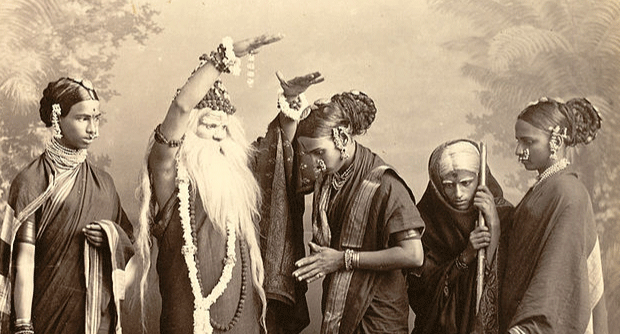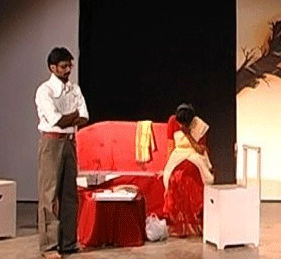One of the meanings of the word Theatre or Theater (American spelling.) applies to a building or outdoor area where in plays and other dramatic performances are given. Though there are several other meanings , we are not concerned with other meanings.
In Sanskrit literature,
Drama was considered as the highest form of literature.It was the only earliest form of Theater available in the Theater history of India that dates back to First century BCE. The most celebrated Dramatist of this period was undoubetedly Kali Dasa, who has written the classical romantic plays like Abhignana Sakuntalm ,Malavikagnimitram and Vikramorwaseeyam.
The purpose of Drama
" Kavyeshu Natakam Ramyam", means, of all the literary genres, Drama is considered as the best.
Drama is mainly intended to entertain, to teach and propagate morals and good conduct among the people. This was also used to spread the goodness of a particular genre of literature. In all it should be agreed that Drama has been widely recognized all over the world as a powerfyl tool of communication.
The theater in India emerged only afte the development of classical Greek Drama. The period between first century and tenth century CE was marked in the history as the "peaceful Period.". Owing to this reason,several classical dramas were written and presented. But the Indian Theater, with the advent of Islamic invasions during 10th and 11th centuries had to take the blunt of foreign invasions and its decline started.Bharat Muni's Natyasaastra gives a vivid description of Sanskrit drama and its different manifestations pertainig to a gamut of all theatrical practices of ancient Drma.
Any literary genre cannot be isolated from the contemporary conditions. Drama is not an exception. Indian theater to undergone several changes over a period. Though its not necessary to discuss all the changes that Drama has undergone, it's essential to classify the development of Indian Theater in to two broad categories.
- Pre-independence period
- Post-independence period.
Drama in pre-Independence period
Drama in pre-independence days are mostly patronised either by kings or local Chiefs. During this period most of the patrons used to have their own court writers. In some cases, the writers were given freedom to express their thoughts about anything and write about them . In the other case,the king or his kin used to specify a particular theme of their own choice and liking. It may be about theKing's biography or some war exploitations.
The most notable dramas that emerged during this period include Rabindranath Tagore's Chitrangada,1892. Raja 1910,Dakghar 1913,Raktakarabi1924.
Drama in post-Independence period
Drama, after the independence has unfurled its many brilliant traits owing to the freedom of expression.A plethora of revolutionary changes took place in almost all the spheres of Indian Drama. Most of the traditional forms of theater which went into oblivion due to lack of patronisation staged a grand comeback. Among the most notable forms of Indian theater that took a rebirth are Kutiyattam, of Kerala,Bhavai of Gujarat,Jatra of Bengal, Swang, a popular form of Indian folk theater popular in the states of Haryana, Uttar pradesh and Malwa region of Madhya pradesh.Yakshagana, a popular theater art of Karnataka. Kathakali, a form of dance-drama from Kerala.Temple-art plays gave birth to Krishnanattam and Rmanattam in Kerala.
Spontaneity is the key
It's a special kind of theater, used for educational and entertainment purposes. This theater's speciality contains in a direct interaction between the audience and the actors. On the suggestions of the audience, the actors improvise. This calls for an extraordinary skill level in the performers on the stage.
Improvisational theater owes its origin to an improvisational theater group called Janasanskriti led by Sanjay Ganguly.
Regional Resurgence
The noteworthy aspect is the Indian theater did not stick to a particular region or an area. A large scale development has been simultaneously was witnessed in many regions of the country. Notable among them are
- Maharashtra
- Bengal
- Telugu
Uniqueness of Marathi theater
Marathi theater survived the threat of extinction from its rivall, cinema though cinema lived in its very next door.The early period of Marathi theater was dominated by a new ngenre of theater known as Sangeet Natak. This genre, as the name clearly says, is a combination of music and dialogue. Owing to this reason, Sangeet Natak has become a fertile breeding ground for the giants of music field like Bal Gandharva,Dinanath Mangeshkar, Keshvrao Bhosle to name a few.
Bengal Theater
The very name of Bengal theater conjures up Jatra. the meaning of which in Sanskrit is Procession. Its original Sanskrit word is Yatra. After the independence of India, the leftist parties used Jatra as a propaganda tool. The stage used for Jatra performance is open stage from all sides unlike conventional stage which is open from one side only.
A jatra performance usually starts with a musical performance that may last for an hour. The whole jatra performance lasts for a long time which may be three to Four hours.In the initial stages, though the female characters were done by males, gradually with time, females entered the Jatra realm for portraying female roles.
Hindi Theater
Under this head, many states in north India, a few parts of west India, central India are covered where Hindi theater is popular. Hindi theater owes its origin to the traditional folk theater of North India.
Hindi theater that had its genesis in the late 19th century was reformed by the efforts of play wrights, Jayashaar Prasad andMohan Rakesh reached its pinnacle around 1940s and n1950s. It was further fortified by the IPTA, Indian People's theater Association. Prithvi theaters led by legendary Prithviraj Kapoor and Habib Tanvir, Hindi theater laid strong inroads into then heart of Hindi mainland.
With the establishment of National School of Drama in Delhi in 1959, India's Theater took a new turn. NSD, National School Of Drama, which was under Sangeet Natak Academy has become independent and autonomous. Stalwarts like Ebrahim Alkazi and Shanta Gandhi gave muscle and bone to NSD with their pioneering works especially that of Ebrahim Alkazi's. Ebrahim Alkazhi turned a new leaf in the History of Indian Theater by adopting the Sanskrit classic Abhignana Sakuntalam in to Hindi. An epoch making effort indeed
 Telugu Theater
Telugu Theater
The beginning days if Telugu theater was completely dominated by Mythological Dramas, which were basically 'Poem dominated.' That means all along the length of the play only poems are used rendered musically. These DEramas are well known as"Padya Natakam.'
The year1890 has seen a revolutionary change in the history of Telugu Drama. After staging Kandukuri Veeresa Lingam's Vyvahara Dharma Bodhini, Many play wrights started writing about social problems putting an end to mythological drams. The icing on the cake was the dialogues were written in day to day language. No more poems.
Gurajada Appa Rao completely changed the course of Telugu drama with his ground breaking play "Kanya Sulkam." he took a social evil in the marriage institution and made it as his central theme for the play. Above all contrary to the then convention of 'Poem Dramas". he has written in day to language. This has raised a storm in the "Purist" literay circles. The language used in the drama was described by the purists as "Bazaar Language."
Undisturbed Appa Rao moved ahead by penning some more historical works. His " Kanya Sulkam" was staged repeatedly to the packed audience. Andhra Drama has come of age atlast.
Famous Play wrights.of Modern era
- Prithviraj Kapoor ( Hindi, Urdu)
- Utpal Dutt (Bengali)
- Mohan Rakesh (Hindi)
- Abhimanyu (Malayalam)